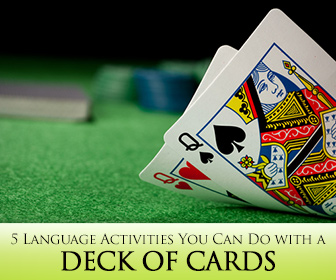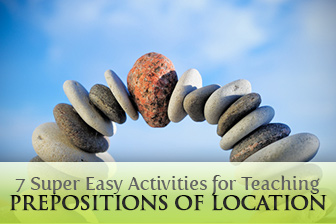Deal with It: 5 Simple Language Activities You Can Do with a Deck of Cards


These prepositions can be a challenge for English language students. Some prepositions do not translate from one language to another, and even when they do they are often not used in the same context.
The more practice you give your class with these information packed words the easier it will be for your students to use them easily in conversation. These 7 simple activities, most requiring little to no preparation, can give your students the practice they need to be in the know when it comes to prepositions of location.

Have pairs of students take turns saying where items in the classroom are without saying the object itself. For example, a student could say, “This object is over the door.” The second student guesses which item his partner is describing. “Is it the clock?” If the student gets the answer right, they switch roles. This is also a good way to review vocabulary of classroom objects.
To practice prepositions of location in question form, have pairs of students work together in an activity similar to the previous one. This time, though, the first student asks a question about a classroom item using a preposition of location that does not describe the object’s correct location. “Is the clock under the trash can?” The second student then answers the question. “No, the clock is over the door.”
Have students bring an unusual item to class or provide one yourself. Then let students take turns hiding the object in the classroom while the other students hide their eyes. Once the student is back in his seat, his classmates ask questions using prepositions of location to try to locate the item. The person who hid the object answers their questions until someone guesses correctly. The person who guesses correctly gets to hide the item for the next round.
This pair activity requires one student to give directions to another student while he draws a picture. Give one student a simple picture, which she will have her partner draw. She can look at the picture, but her partner can only listen to her directions as he draws. Encourage your students to use prepositions of location as they give their partners instructions. Then have students switch roles with another picture.
Show your students a picture of a messy bedroom. Ask them what is wrong with the picture and where the person’s items should be. For example, if clothes are on the floor your students would say, “The clothes should be IN the closet.”
Have groups of three or four students work together to create a map of a fictional town. The map should include typical buildings like a school, library, police station, grocery store and homes. Have students discuss where each of the buildings should be located on the map using prepositions of location. Once the maps are finished, have each group present theirs to the class. Their classmates can then ask them why they put each building where they did. For example, “Why is the school next to the library?” The group who made the map should answer their classmates’ questions.
Have an egg hunt in your classroom — no matter what time of year it is. Hide several plastic eggs around your classroom (you can put something inside them or leave them empty). On your word, students start looking for the eggs around the classroom. When someone finds an egg, he announces it to the class. He should then tell the class where he found it. “I found an egg. It was under the teacher’s chair.”
Though perfect for beginning level students who are just learning these prepositions, they are also useful for more advanced students who need a review or for filling a few minutes at the end of class.
At what point in your curriculum do you cover prepositions of location?